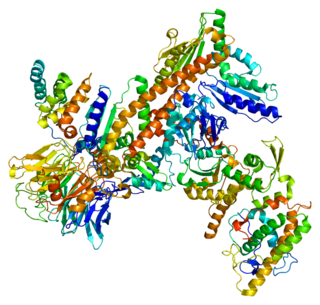Actin-related protein 2/3 complex subunit 5 is a protein that in humans is encoded by the ARPC5 gene. [5] [6] [7]
Actin-related protein 2/3 complex subunit 5 is a protein that in humans is encoded by the ARPC5 gene. [5] [6] [7]
This gene encodes one of seven subunits of the human Arp2/3 protein complex. The Arp2/3 protein complex has been implicated in the control of actin polymerization in cells and has been conserved through evolution. The exact role of the protein encoded by this gene, the p16 subunit, has yet to be determined. [7]

Cortactin is a monomeric protein located in the cytoplasm of cells that can be activated by external stimuli to promote polymerization and rearrangement of the actin cytoskeleton, especially the actin cortex around the cellular periphery. It is present in all cell types. When activated, it will recruit Arp2/3 complex proteins to existing actin microfilaments, facilitating and stabilizing nucleation sites for actin branching. Cortactin is important in promoting lamellipodia formation, invadopodia formation, cell migration, and endocytosis.

Actin-related protein 3 is a protein that in humans is encoded by the ACTR3 gene.

Actin-related protein 2 is a protein that in humans is encoded by the ACTR2 gene.

Wiskott-Aldrich syndrome protein family member 2 is a protein that in humans is encoded by the WASF2 gene.

Wiskott–Aldrich syndrome protein family member 1, also known as WASP-family verprolin homologous protein 1 (WAVE1), is a protein that in humans is encoded by the WASF1 gene.

Actin-like protein 6A is a protein that in humans is encoded by the ACTL6A gene.

Alpha-centractin (yeast) or ARP1 is a protein that in humans is encoded by the ACTR1A gene.

Actin-related protein 2/3 complex subunit 1B is a protein that in humans is encoded by the ARPC1B gene.

Prefoldin subunit 1 is a protein that in humans is encoded by the PFDN1 gene.

Actin-related protein 2/3 complex subunit 2 is a protein that in humans is encoded by the ARPC2 gene.

Wiskott-Aldrich syndrome protein family member 3 is a protein that in humans is encoded by the WASF3 gene.

Metastasis suppressor protein 1 is a protein that in humans is encoded by the MTSS1 gene. True to its name, it codes for a metastasis suppressor.

Actin-related protein 2/3 complex subunit 3 is a protein that in humans is encoded by the ARPC3 gene.

Actin-related protein 2/3 complex subunit 4 is a protein that in humans is encoded by the ARPC4 gene.

Actin-related protein 2/3 complex subunit 1A is a protein that in humans is encoded by the ARPC1A gene.

Beta-centractin is a protein that in humans is encoded by the ACTR1B gene.

Actin-related protein 3B also known as ARP3-beta is a protein that in humans is encoded by the ACTR3B gene. Pseudogenes of this gene are located on chromosomes 2, 4, 10, 16, 22 and Y. Alternative splicing results in multiple transcript variants and protein isoforms.

The Actin assembly-inducing protein (ActA) is a protein encoded and used by Listeria monocytogenes to propel itself through a mammalian host cell. ActA is a bacterial surface protein comprising a membrane-spanning region. In a mammalian cell the bacterial ActA interacts with the Arp2/3 complex and actin monomers to induce actin polymerization on the bacterial surface generating an actin comet tail. The gene encoding ActA is named actA or prtB.

Arp2/3 complex is a seven-subunit protein complex that plays a major role in the regulation of the actin cytoskeleton. It is a major component of the actin cytoskeleton and is found in most actin cytoskeleton-containing eukaryotic cells. Two of its subunits, the Actin-Related Proteins ARP2 and ARP3, closely resemble the structure of monomeric actin and serve as nucleation sites for new actin filaments. The complex binds to the sides of existing ("mother") filaments and initiates growth of a new ("daughter") filament at a distinctive 70 degree angle from the mother. Branched actin networks are created as a result of this nucleation of new filaments. The regulation of rearrangements of the actin cytoskeleton is important for processes like cell locomotion, phagocytosis, and intracellular motility of lipid vesicles.